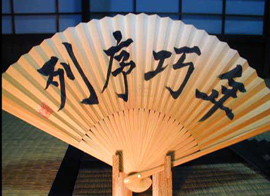Learn About Japan > Work and Workplaces in Japan > Employment > The Seniority Wage System (nenkō joretsu)

|

Employment
- Group Employment Trips
- Spring Employment Season
- Hiring New Graduates
- Hiring New High School Graduates
- The Japanese Employment System
- Lifetime Employment
- The Seniority Wage System (nenkō joretsu)
- The Bonus System
- Enterprise Unions in Japan
- Enterprise Union Cooperation
- Unemployment Insurance
- Dual Tracks in Female Occupations: Ippan Shoku (Non-Career Track) and Sōgō Shoku (Career Track)
- Increase of Female Employees
- Female dominant occupations
- Post-Retirement Employment and Social Security
- Marriage Retirement and Retirement Ages for Men and Women
- Relations between Large and Small Companies
- Part-time Female Workers
- What Kinds of Work Do People Do in Japan?
- Freeter/ Furita: Part-Time Workers in Japan
|

A hand fan that reads "Seniority by length of
service."
Photo from Fudemojiya.
The Seniority Wage System (nenkō joretsu)
The seniority-based wage system (nenkō joretsu) has gone hand in hand with lifetime employment. Companies maintain very broad employment categories or ranks, rather than paying employees for the particular jobs they perform. Employees begin with a standard basic wage, and receive an increase in pay for each year of service. An employee who leaves to join another company would start from a lower end of that company’s wage scale and his or her income could be lower than other employees' of the same age in the same company. The seniority-based wage system keeps workers from changing jobs, since after a few years of employment they enjoy a wage level that they could not match if they moved to another company.The seniority-based wage system underpays young workers, but rewards them well in later years, even if their productivity declines. It offers workers a strong incentive to remain with their first employer.An early retirement age also supports the seniority wage system, normally forcing employees to retire from their regular positions at age 55 to 62. After formal retirement they may be rehired by the same firm under short-term contracts, or may take other temporary employment until they are truly ready to retire several years later.
|
Special Terms:
contract
|
| Download Podcast in
English
| Japanese
|
|
Document |
Audio-Video |
Chart |
Picture |
Map
|
|

